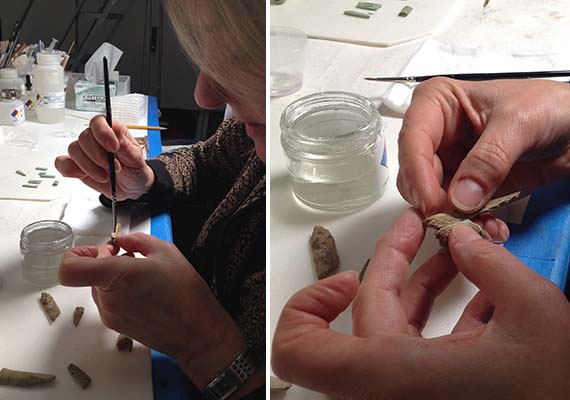Over the past few months, the wooden trays (below), in which the fragmentary auloi traveled the long distance from the site of Meroë in northern Sudan to Boston and in which they have been housed for almost 100 years, were documented using high resolution digital photography.

All auloi fragments were removed from these inadequate and potentially dangerous containers, which had allowed the fragile parts to roll into each other. The pieces were re-housed in state-of-the-art archival storage trays with an interior modular system of smaller boxes configured to serve the needs of each particular tray.

In the process, the individual pieces were cross-checked against earlier images, and their locations noted to record adjacencies which may prove to be important for future reconstruction. Since connections will be made between fragments during this project, individual pipes will grow in length and storage and housing systems may require adjustment in the future.
The organic and inorganic fragments are currently being examined and documented in great detail. Special features of the metal elements, such as corrosion products, remnants of organic fibers, and different surface textures and colors (which may indicate different alloy composition), are noted for future analysis.
Below are double bronze tube segments with bone lining (left) and a slider with terminal in the shape of a dolphin holding a large shell in its snout (right).

Key fragments will be documented using a digital microscope, which allows taking detailed measurements of individual features such as thickness of metal and diameter of tubes and holes.

Many joins between fragments were readily identified and numerous broken parts have already been reattached. Bone and bronze fragments (below) were joined as much as possible using a conservation grade acrylic adhesive, which will remain easily removable in the future. Many hundreds of segments still wait to be joined in a meticulous process which is likely to take many more months.

The dark spots on the straight section of the reconstructed bone bulb pictured below are traces of highly corroded silver, indicating that the bone was carried in a narrow silver sleeve.

The thin-walled copper alloy tubes show distinctive patterns, related to the micro burial environment which surrounded them. These features allow identification of pieces that belong to one tube. However the thin walls of the heavily corroded and sometimes also mineralized metal have occasionally warped, complicating the reconstruction of the original forms.
Based upon visual examination only, the light green-colored lining of many pipes, as well as their bulbs and bells, so far appear to have been predominantly carved from bone. Their green color is caused by copper corrosion which migrated into the soft organic material over long periods of time and has now permanently stained the bone. Different parts of the pipes appear to have been carved from different types of bones, judging by their surface textures. Such slight variances and the occasional surface decoration in the form of thin incised lines aid in finding joins between the numerous small fragments.
At the moment, the identification of full pipes is not yet possible. Conservators hope that in a few months a small number of full pipes can be assembled, at least through establishing adjacencies, as the physical joining of the heavily compromised substances in long sections may not be feasible.
Most metal elements will also be examined by X-radiography. A number of selected pipe fragments of complex shapes will be further examined by CT-scanning. These studies may provide further insights into the construction of the individual pipes.